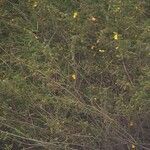Leaves 20–40-foliolate; leaflets 8–26.5 × 4–10 mm, oblong, truncate or slightly emarginate at the apex, obliquely rounded at the base, entire, somewhat glaucous beneath, glabrescent above, pubescent with slightly tubercular-based short hairs and often minutely asperulous on the margins and midnerve beneath; venation dark beneath; petiole and rhachis together 4–16 cm long, densely covered with stiff bristly hairs and shorter pubescence and also often with short spinelets; petiolules 0.5–1 mm long; stipules 10–13 × 6–9 mm, broadly ovate, auriculate on one side only, velvety, eventually deciduous.
A shrub or small tree. It grows about 9 m tall. The stem is swollen and almost cone shaped. It has sticky hairs. The stem is soft. The leaves have 20-40 side leaflets and these are 1-3 cm long by 1 cm wide. They are oblong but flattened at the top and rounded at the base. There are some hairs underneath. There are 1-4 flowers on a stalk 1.3 cm long. The flowers are large and orange-yellow. The fruit are twisted pods. They are 10-14 cm long. They have lumpy hairs. The seeds are dark purple-brown. They are kidney shaped and 6 mm long by 4 mm wide and 2 mm thick.
Fruit spirally contorted, 10–14 cm long when unrolled, 6–17-jointed, densely covered with glandular bristly tubercular-based hairs and with short pubescence as well; articles 6–8 × 7–9 mm, ± oblong or trapeziform, venulose beneath the dense indumentum.
Inflorescences axillary, 1–4-flowered; peduncle 1.3 cm long; rhachis 1–4.5 cm long; pedicels 12–16 mm long; bracts 6–7 × 3–5 mm; bracteoles asymmetrical, 10–16 × 5–10 mm, ovate or elliptic, velvety.
Calyx densely pubescent and with longer sticky bristly hairs, 2-lipped; lips entire or 2–3-toothed at the apex, one 19–25 × 6–12 mm, ovate-lanceolate, the other, 15–20 × 6–11 mm, ovate-oblong.
Standard yellow to orange, 3–4.7 cm long and wide, rounded, emarginate, puberulous above on outer surface; wings and keel yellow, the petals of the latter laciniate along their lower margins.
Seeds dark purplish-brown, 6 × 3.8 × 2 mm, reniform, with a slightly eccentric hilum, slightly beaked resembling the front of a canoe.
Shrub or small tree, 2–9(12) m tall, with a swollen pithy often almost conical stem acting as a float.
Stems with short and long sticky hairs and nearly always with short sharp spines 2–15 mm long.
Flowers large, orange-yellow.
A shrub, 8–20 ft. high



